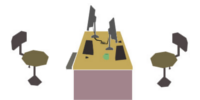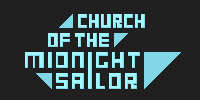Interview: DECEIVER’s Evan Todd
Set amidst the impending doom of a cyberpunk city, DECEIVER invites players to hurtle spider drones at everything in sight (including enemy heads) in an attempt to gain enough resources to survive. On a deeper level, Helvetica Scenario developer Evan Todd embeds the game with philosophical scenarios, asking players to ponder their circumstances; I chatted with Evan (a Kickstarter campaign in full swing), noting his keen attention to visual detail, dedication to a unique narrative framework, and connection to the Handmade movement.
Erik Meyer: I’m interested in the philosophies driving the game and the ways in which these larger concepts come across to players. What do you see as the big questions that receive novel treatment in DECEIVER, and what pushes players to grapple with these heady ideas?
Evan Todd: I would never claim to create something truly novel – does such a thing exist? Instead, it’s a mashup of stuff that has come before. It’s interested in the way people search for meaning when there doesn’t seem to be any. How do people react in the face of certain death? Do they find the will to live the best they can until they end, or do they give up? And if they do find it, where does it come from? Two years ago, when I was first thinking about this, I read a lot of Camus and Kierkegaard. So I want to put players in a challenging place and then ask them whether they want to be the Absurd Man, or the Knight of Faith, or something else entirely.
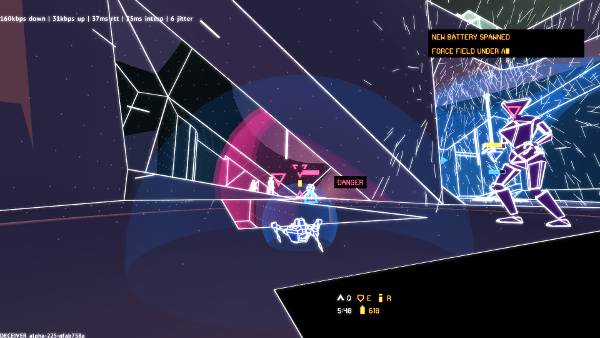
EM: With regard to the user experience, you’ve spoken about how you’re pacing the plot/interactions that reveal this larger conceptual picture by way of environmental storytelling and player interaction (as opposed to heavy reliance on text, cutscenes, etc), so to this end, what is your methodology?
ET: It’s a case-by-case thing, but basically I strive for that tired old adage: “show don’t tell”. The ideas I have are simple. So instead of having a character talk about the pain of loss, I take away all your character’s money. Instead of popping up a big UI with two choices on it, I give you two doors to walk through. That’s not to say there are no cutscenes or text, but rather that they serve to give context to the real meat, which is what’s happening to you, the player.
EM: The game employs a unique visual look, an architectural line feel with purples and blues that pop, so can you describe your art design preferences and the blueprint behind your aesthetic?
ET: I always loved the glowing lines of TRON. And I always loved watching footage of work-in-progress games being developed without textures, where everything is white and you can see the form of things without being distracted by texture. It’s difficult to perceive the quality of a model when it’s hidden under textures and specular highlights. Strip it down to plain white material under a three-point light setup and you can see every last detail. That said, the exact details of the aesthetic in DECEIVER are a result of iteration and the occasional happy accident. The dot patterns along all the surfaces came from me turning on AI debug renderer and thinking, “that looks nice!”
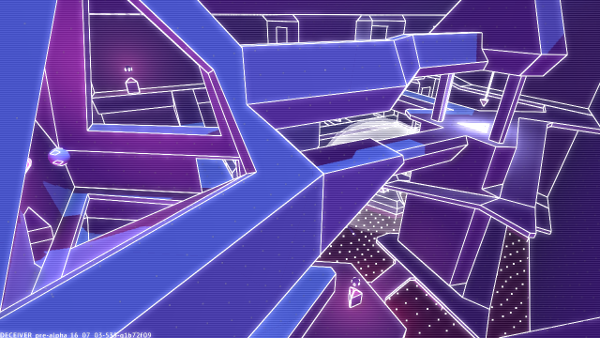
EM: The grepr prototype established the atmosphere and some storytelling tools as a start of the project; at which point during that time did you have the kernel, the genesis, the ‘aha’ moment that put the wheels in motion?
ET: The first “aha” moment actually came before I started the prototype. That core idea remained the same from the prototype until now, but the method of communicating the idea has gone through twelve major revisions over the years, and each revision was another “aha” moment. That’s because the story has to serve the gameplay, and vice versa. Every gameplay change, even something as simple as adding a weapon, can change the constraints the story has to operate within. And likewise, every story change opens up some doors in the gameplay while closing others. Hopefully, at the end you’ve opened all the right doors, so the two are in sync.
EM: The spider drone captures resources, which players buy a wide range of upgrades (bolter, shotgun, sniper, active armor, turret, force field, grenade, rectifier, and minion spawner, etc), so while these options all further in-game goals, they also make for a wide variety of play options. From a level design standpoint, how do you avoid a clear best set of options, and how do you encourage creativity therein?
ET: My method is to figure out the vector that describes what makes an ability good, scale that vector as far as it can go, and then, only if necessary, nerf it with a cooldown or something. So the sniper has infinite range, instant bullet travel, and can kill in one hit. The grenade damage radius is about a mile. The minion spawners can fill a whole map with minions in two minutes. The reason this works is that once you choose an ability, the enemy gets to choose how to react to it. I was saving up for the force field, but now that I know you have the shotgun, I’m going for the active armor.
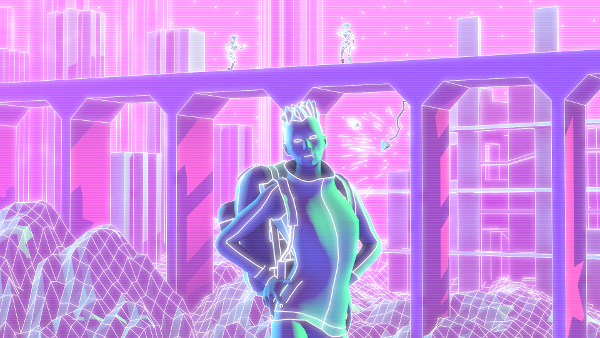
EM: You include yourself in the Handmade movement on your Kickstarter page, meaning the game renders everything – the font, the UI, etc – in vectors as you’ve designed it, so can you speak to the challenges that come with adhering to this particular philosophy as a developer, as well as the freedom and benefits it provides?
ET: Writing things from scratch isn’t for everyone, and it’s not necessarily the “best” way. For me, my projects are so in-depth and long-term that even when I do use an engine or a third-party library, I often end up rewriting it anyway, so I figure I might as well write it myself the first time. Of course, this takes a lot more time, but it means that if I need to change or fix something in the game, I usually know how to do it, whereas many people using an engine are stuck posting in the forums and waiting for a patch release. Ideally, I would understand absolutely everything about the game and the system, right down to the processor. That’s impossible, but I think it’s worthwhile to pursue that goal rather than avoid it.
EM: You mention Half-life, The Talos Principle, and BioShock as titles of inspiration, all of which have deep conceptual messages and a strong spirit of adventure gameplay, so what is it about exploring a map that makes an area (for lack of a better description) ‘interesting’ or ‘exciting’, and as a developer, what pushes you to meet said criteria?
ET: That’s the million dollar question! I think there are a lot of things that contribute to an area’s “interest”, but one I’ve been thinking about lately is the idea of “story circles”, most recently popularized by Dan Harmon. All stories share the same basic anatomy, and we’re all hard-wired to appreciate stories of any size. Gone Home is the master of this technique. Obviously, it has the overarching story about the family, but what really engages you is the story about how you wanted to get into a locked room, ended up rummaging around a spooky basement, found the key, and finally got to see what was in that room.
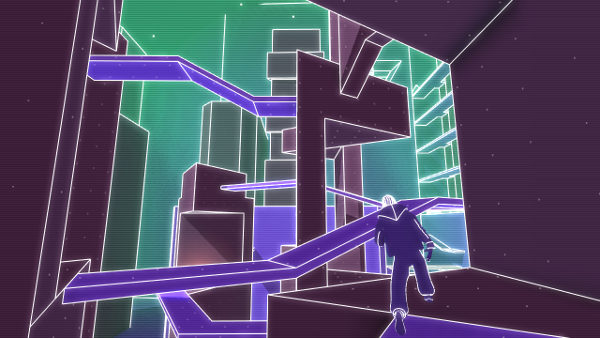
EM: The free virtual servers aspect of the game brings me back to Counter-Strike days, which is a good thing, so when it comes to multiplayer and arena battle elements, what kinds of developer goals come into the picture that are absent in the single player scenario?
ET: Single player is a very curated experience, but in multiplayer, I want to give people as many options as possible. You can disable abilities, make certain abilities the default, make the server private, give everyone 5000% shields, whatever. I want people to find whole new ways to play the game. And the server browser uses a Reddit-style algorithm to hopefully make the most interesting modes bubble to the top.
In case you missed it, here’s the trailer:


